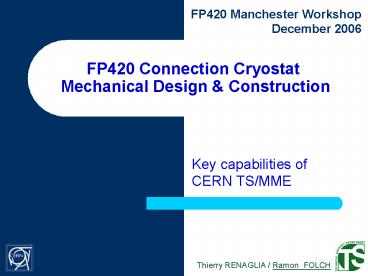FP420 Connection Cryostat Mechanical Design PowerPoint PPT Presentation
1 / 23
Title: FP420 Connection Cryostat Mechanical Design
1
FP420 Connection Cryostat Mechanical Design
Construction
- Key capabilities of CERN TS/MME
2
CONTENT
Mechanical design constructionKey capabilities
of CERN TS/MME
2. CONSTRUCTION
1. DESIGN
- FP420 versus DFB ATM
- Pre-design Version 1
- Pre-design Version 2
- Mechanical analysis
- Pre-design Version 3
- Open issues
- Main processes involved
- Schedule and possible lead times
- Cost drivers
- DFB ATM assembly experience
3. CONCLUSION
- Advantages with CERN TS/MME
- Required framework conditions
3
FP420 versus DFB ATM
- Continuity of the X and C lines
- Higher contraction of the busbar lines
- Fixed point to be relocated
- Longer interconnection bellow length
- Detector constraints (accessibility, precision)
- Radiation shielding
Distribution Feed Box
Arc Termination Module
FP420 Cryostat
4
Pre-design Version 1
- Dipole cold foot to replace compensation system
- Couple two DFB ATM
- Allow contraction of the BB line
5
Pre-design Version 2
- Redesigned supporting beam
- Double cold feet to free space for line X
6
Version 2 Displacement analysis
VACUUM CONDITION
7
Version 2 Displacement analysis
VACUUM CONDITION INTERCONNECTION at cold
(operation conditions)
8
Version 2 Reaction analysis
Cold condition (vacuum, bellow force)
Bellow force - 10000 N
Reaction y 55000 N
Reaction z - 32500 N
Reaction z 70000 N
9
Pre-design Version 3
- Two lowered supporting beams
- One single piece
10
Version 3 Open issues next steps
- Detector supported by the cryostat need to deal
with movements during cooling down and operation - Need of additional central fixed point and
supporting jack - Use the transport buggies and the lifting beams
of the DFBAs - Pre-design v3 approval awaited
11
Construction Processes involved
- Machining (both heavy and accurate)
- Sheet metal forming (vacuum tanks, piping)
- MIG/TIG welding
- Thermal treatments / Surface treatments
- Mechanical fitting (Beam screen integration)
- Metrology / Alignment
- Vacuum test / x-Ray inspection
- Thermal super-insulation
- Electrical insulation assembly and test
12
Schedule projection attempt
Green light needed on time to allow the design
work to start
The production cannot start before the design is
fully approved
13
Cost drivers What helps cutting them
- Re-use existent designed parts (cold feet, jacks,
dished heads, etc) - Experienced and multi-skilled workforce
- Avoid specific tooling
- Optimize the logistics between operations
14
CERN TS/MME experience on DFB ATM
- Design and mechanical analysis
- Full production and assembly of 16 ATM
- Budget and time constraints sealed in a
interdepartmental workpackage agreement
?Results Early deliveries and costs below
expectations after the 3 first units
Distribution Feed Box
Arc Termination Module
15
Shuffling Box assembly
16
Welding of the dished heads
17
Cryostating of the Shuffling Module
18
Thermal Super-insulation
19
Final assembly
20
DFBA (ATM HCM) Transport
21
Conclusions
- Advantages with CERN/TS/MME
- Design and construction synergy benefits
- Shortened learning curve (skilled resources and
appropriate equipment available) - Highly responsive multi-technological environment
- Reduction of the logistics time and cost
- Design and construction traceability (CDD/ EDMS /
MTF) - Required framework conditions
- Obtain the formal approval of the pre-design
- Obtain the final version of the technical
specification - Adopt a workpackage oriented approach combining
the mechanical design and the construction
22
(No Transcript)
23
Thanks for their contribution
- Utilisation des ATM pour le projet FP420 - EDMS
771549 Thierry Renaglia - Use of the ATM for the FP420 Project EDMS 743628
Thierry Colombet - General information from the TS/MME ATM assembly
team (Said Atieh, Laurent Préver-Loiri, Didier
Lombard, and al.)
and thanks for your attention.

